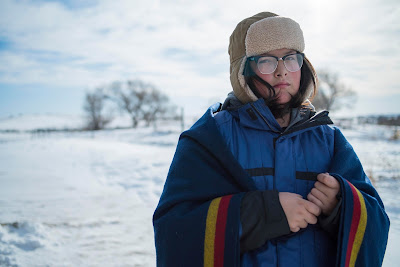Thanne longen folk to goon on pilgrimages,
And palmeres for to seken straunge strondes,
To ferne halwes, kowthe in sondry londes;
And specially from every shires ende
In my head, I've thought of the family trip to Standing Rock as a pilgrimage. I didn't express that - it seemed too silly to say out loud, but now that we are back, I have found that reviewing it as such has helped me be ok with my feelings and the results of our experience. It turns out my experience is not atypical at all. It follows the pattern of the pilgrimage. Learning this has somehow helped me feel whole.
PBS has a great definition of Pilgrimage on its Sacred Journeys page (http://www.pbs.org/wgbh/sacredjourneys/content/pilgrimage/). In its description, PBS lists 6 stages to a pilgrimage.
1. THE CALL. This is described as a longing or yearning.
We were not the only people to feel a call to the Cannon Ball river. The people we met in Oceti Shokowin expressed this same feeling. Before going north, my son Mason spoke to someone who spent months in the Red Warrior camp. She told him, "Everyone who feels the call should travel to Standing Rock." I have spent ample time in early blogs expressing the longing we all felt to go to Oceti Shakowin and add our prayers to those being uttered there.
2. THE SEPARATION. Separation comes from suspending day-to-day worries and placing your trust in a higher power.
Our pilgrimage to the Oceti Shakowin camp did one better. Even though I upgraded our phones to ensure better coverage out-of-state. We still found ourselves disconnected from the world wide web more often than not. This natural state of unplugged help me to suspend my worries of work and obligation and tomorrow. I was able to participate fully in the here and now.
3. THE JOURNEY. The rougher the journey, the more successful the pilgrimage.
From inception our journey has been about faith. The physical journey did not vary from that theme. We had originally planned to travel on Christmas day, but I was not able to reserve lodging. Christmas morning included a large snowstorm in Utah and a blizzard in North and South Dakota. We left the next day - glad to have missed the blizzard. The roads throughout the four states we traveled showed the aftermath of the winter storm. We had periods of drifting snow, flying rocks, and blowing snow so thick visibility extended to the length of an arm. We also had periods where the snow cleared and we saw bald eagles lift off from the roadside. Despite our hardships, we felt blessed and supported.
4. THE CONTEMPLATION While some pilgrims head straight for their goal, others take a round-about route.
We took detours on our way to and from Standing Rock. We went out of our way to visit the Wounded Knee Massacre Site. This was a solemn time of prayer and reflection, of gratitude and sorrow.
On the way home we made an impromptu visit to Devils Tower, a sacred site where prayers have been made for hundreds, if not thousands of years.
6. THE CONTEMPLATION and RETURN "At the culmination of the journey, the pilgrim returns home only to discover that meaning they sought lies in the familiar of one's old world."
This phase of our pilgrimage was the most surprising for me. Upon our return, I felt an emptiness where the yearning had been. Rather than wishing to return, my attitude had changed. I want to pray at home. I want to see what I can do locally, whether that be support calls for clean air and preservation of sacred sites in Utah, or to recommit myself to recycling and personal conservation efforts.















Would love to hear even more. Marilyn Richardson
ReplyDelete